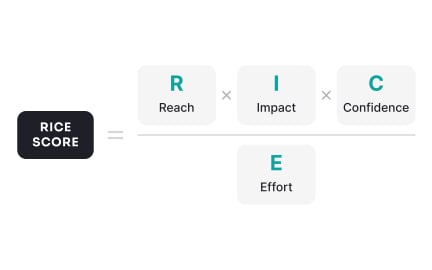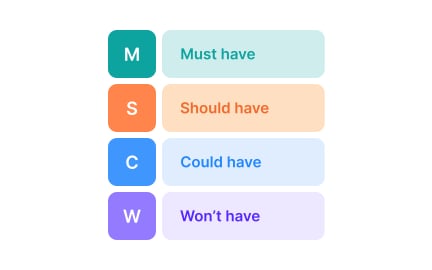2x2 Prioritization Matrix
The 2x2 prioritization matrix helps teams compare ideas using two factors, such as effort and impact, to decide what to focus on or delay.
What is 2x2 Prioritization Matrix?
Your team wastes time debating priorities because complex scoring systems and endless criteria create analysis paralysis, leading to delayed decisions and frustrated stakeholders when simple choices require complex frameworks that obscure rather than clarify what matters most.
Most teams overthink prioritization with elaborate frameworks without recognizing the power of simplicity, missing how 2x2 matrices can drive quick, clear decisions by plotting options on two critical dimensions that reveal optimal choices instantly.
A 2x2 prioritization matrix is a decision-making tool that plots options on two axes representing critical factors (like impact vs. effort), creating four quadrants that immediately show which items to pursue, avoid, or defer based on their position.
Teams using 2x2 prioritization matrices make decisions 75% faster, achieve 60% better stakeholder alignment, and execute significantly more high-value work because visual simplicity cuts through complexity to reveal what matters rather than hiding insights in spreadsheets.
Think about how the Eisenhower Matrix revolutionized time management with urgent vs. important axes, or how product teams use impact vs. effort matrices to identify quick wins and avoid thankless tasks through simple visualization.
Why 2x2 Prioritization Matrix Matters for Decision Speed
Your prioritization discussions drag on endlessly because multiple criteria and stakeholder opinions create confusion without resolution, leading to delayed action and opportunity costs when teams can't agree on what to do first without clear framework.
The cost of complex prioritization compounds through every delayed decision and missed opportunity. You waste time in meetings, frustrate teams with indecision, miss quick wins, and lose momentum when analysis replaces action without proportional improvement in choices.
What effective 2x2 matrices deliver:
Faster decision-making through visual clarity because plotting on two dimensions instantly reveals priorities rather than complex calculations that obscure insights.
When teams use 2x2 matrices properly, decisions happen in minutes rather than hours of debate without clear resolution framework.
Enhanced stakeholder alignment through simplicity as everyone can understand and contribute to visual prioritization rather than complex scoring that excludes participants.
Improved action bias and momentum because clear quadrants drive immediate next steps rather than continued analysis without decision.
Better resource allocation through obvious identification of high-impact, low-effort opportunities rather than treating all initiatives equally.
Stronger strategic focus as matrices force choice of two critical dimensions rather than trying to optimize everything simultaneously.
Step 1: Choose Two Critical Dimensions (30 minutes)
Select the two factors that matter most for your decision rather than including every consideration, forcing focus on what drives real value versus nice-to-have criteria.
This creates matrix foundation based on essential trade-offs rather than comprehensive analysis that prevents clear decisions through complexity.
Step 2: Define Axis Scales Clearly (30 minutes)
Establish what high and low mean for each dimension rather than vague positioning, ensuring consistent evaluation across different items and evaluators.
Focus scale definition on relative rather than absolute measures, enabling quick positioning without precise calculations that slow decisions.
Step 3: Plot Items Collaboratively (1 hour)
Position options on matrix as a team rather than individual assessment, building shared understanding through discussion about placement.
Balance discussion with decision speed to prevent endless debate about exact positioning when quadrant matters more than precise coordinates.
Step 4: Identify Action for Each Quadrant (30 minutes)
Define what to do with items in each quadrant rather than just visualization, turning matrix into action plan not just pretty picture.
Step 5: Review and Adjust Regularly (Monthly)
Update matrix as circumstances change rather than one-time exercise, maintaining relevance while avoiding constant re-prioritization.
This ensures 2x2 matrices drive sustained action rather than single decision without follow-through or adaptation.
If matrices don't accelerate decisions, examine whether you've chosen truly critical dimensions rather than arbitrary axes without decision power.
The Problem: Choosing wrong dimensions that don't differentiate options, creating matrices where everything clusters in one quadrant without clear priorities.
The Fix: Test dimensions for spread rather than theoretical importance, ensuring axes create meaningful differentiation between options.
The Problem: Over-precision in plotting that creates arguments about exact position rather than focusing on quadrant-level decisions.
The Fix: Emphasize quadrants over coordinates rather than precise placement, remembering that matrix enables decisions not mathematical accuracy.
The Problem: Using 2x2 matrices for everything when some decisions need different frameworks, forcing simplicity where complexity serves better.
The Fix: Reserve matrices for appropriate decisions rather than universal application, recognizing when two dimensions capture essence versus oversimplify.
Create 2x2 prioritization approaches that accelerate decisions rather than adding visual complexity to analysis paralysis.
Recommended resources
Courses

HTML Foundations

Enhancing UX Workflow with AI

CSS Foundations
Lessons

Ruthless Prioritization

The Frameworks that Guide You






